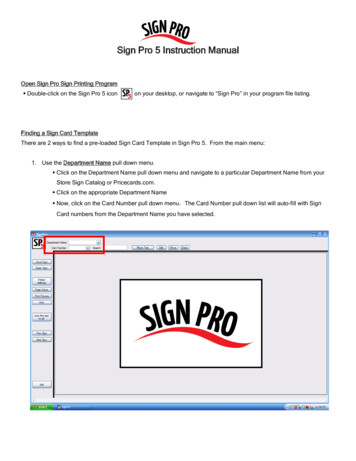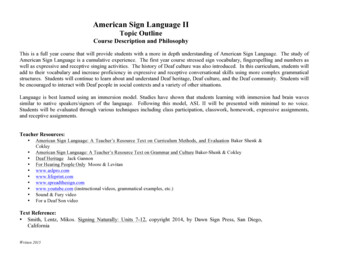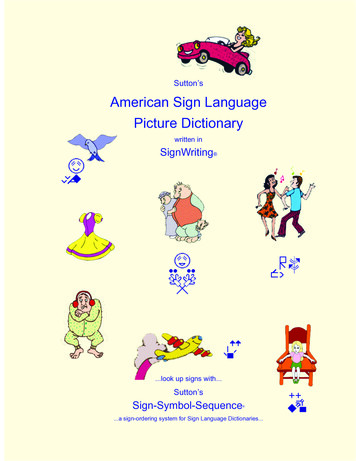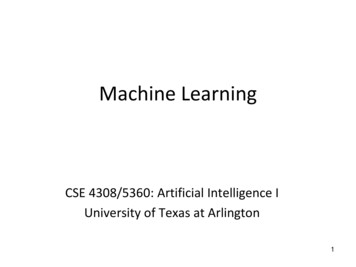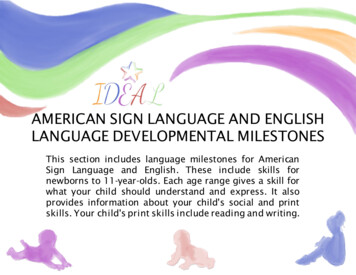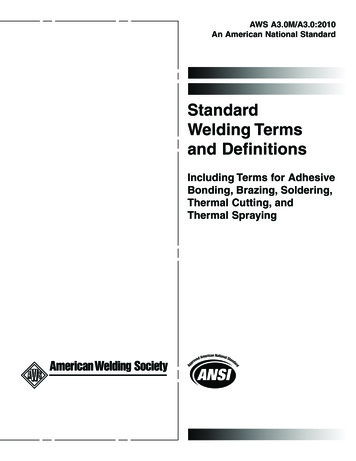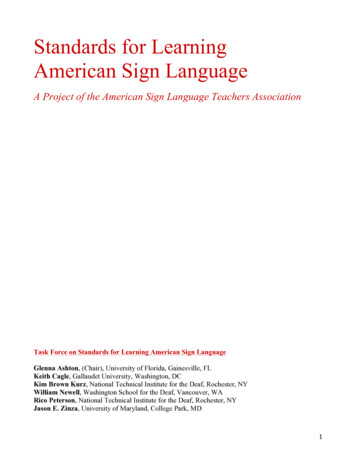
Transcription
Standards for LearningAmerican Sign LanguageA Project of the American Sign Language Teachers AssociationTask Force on Standards for Learning American Sign LanguageGlenna Ashton, (Chair), University of Florida, Gainesville, FLKeith Cagle, Gallaudet University, Washington, DCKim Brown Kurz, National Technical Institute for the Deaf, Rochester, NYWilliam Newell, Washington School for the Deaf, Vancouver, WARico Peterson, National Technical Institute for the Deaf, Rochester, NYJason E. Zinza, University of Maryland, College Park, MD1
ReviewersElizabeth BonniHillsborough Community College, FLElla Mae LentzBerkeley City College, CA (ret.)Cathi BoutonUniversity of Alaska – Fairbanks, AKApril McArthurWashington School for the Deaf, WAKaren BoydUniversity of Colorado - Boulder, COKen MikosCalifornia State University – East Bay,CA (ret.)Jennifer ChristiansonWashington School for the Deaf, WAMolly EstesOhio School for the Deaf, OHJami FisherUniversity of Pennsylvania, PAFlavia FleischerCalifornia State University – Northridge, CALarry ForrestalCalifornia State University – San Diego, CALance ForshayUniversity of Washington, WAKeith Gamache, Jr.Brigham Young University, UTPam HowardArizona State University, AZE. Lynn JacobowitzGallaudet University, DCRussell RosenTeachers College, Columbia University,NYAmy June RowleyCalifornia State University – East Bay,CACynthia SandersNational Technical Institute for the Deaf,NYKristin ScheibeUniversity of Wisconsin – Eau Claire, WIAdonia SmithIndependent consultant – Frederick, MDCheri SmithBerkeley City College, CAPhyllis Perrin WilcoxUniversity of New Mexico, NMThomas WillsBeaverton Public Schools, ORSpecial thanks for their valued contributions to the Learning Scenarios portion of this document: KarenBurnside (FL), Shawn Olmstead (FL), Lynn Steinberg (VA), and Grace Wilkin-Yoder (FL). Thecommittee is grateful for the work of Linda C. Tom and Perseus McDaniel, ASL illustrators, andKatasha Walker, sign model.2
AcknowledgmentsAmerican Council on the Teaching of Foreign Languages (ACTFL)American Sign Language and Interpreter Education Department at Rochester Institute ofTechnology/National Technical Institute for the Deaf (RIT/NTID), Rochester, NYAmerican Sign Language Teachers Association (ASLTA)Central Piedmont Community College, Charlotte, NCDawnSignPress, San Diego, CAFlorida Chapter of ASLTA (FASLTA)Fluent Language Solutions (FLS), Charlotte, NCNational Consortium of Interpreter Education Centers (NCIEC), Northeastern University, Boston, MASign Media, Inc., Burtonsville, MDStandards Collaboration Board (SCB)Washington School for the Deaf, Vancouver, WA3
Table of ContentsStandards for Learning American Sign Language5IntroductionThe Current Status of Teaching and Learning American Sign Language in the United StatesPaths to ASLHistory of ASL in the United StatesCharacteristics of ASLChallenges of Learning American Sign LanguageASL LiteracyDeaf Culture in the 21st CenturyThe Standards for Learning ASL in the 21st CenturyThe Nature of the DocumentAdapting the Sample Progress Indicators to Reflect Multiple Entry Points6777899101010COMMUNICATIONGoal 112CULTURESGoal 222CONNECTIONSGoal 330COMPARISONSGoal 437COMMUNITIESGoal 545Learning Scenarios, Grades K-4Animal FarmOuter SpaceCarnival of the Animals515152Learning Scenarios, Grades 5-8Living FolktalesVital StatisticsExploring Occupations535354Learning Scenarios, Grades 9-12“Deaf Friendly” Home DesignFamiliesVideo Pen Pals555657Learning Scenarios, PostsecondaryDeaf Sports OrganizationsPlanning an ASL BanquetDe’VIA: Artwork by Deaf Artists585960Frequently Asked Questions About American Sign Language614
Standards for LearningAmerican Sign LanguageCommunicationGOAL ONECommunicate in American Sign LanguageStandard 1.1 Students engage in conversationsand correspondence in American Sign Language toprovide and obtain information, express feelingsand emotions, and exchange opinions.Standard 1.2 Students comprehend and interpretlive and recorded American Sign Language on avariety of topics.Standard 1.3 Students present information,concepts, and ideas in American Sign Language toan audience of viewers on a variety of topics.CulturesGOAL TWOGain Knowledge and Understanding of DeafCultureStandard 2.1 Students demonstrate anunderstanding of the relationship between thepractices and perspectives of American Deafculture.Standard 2.2 Students demonstrate anunderstanding of the relationship between theproducts and perspectives of American Deafculture.ConnectionsGOAL THREEUse American Sign Language to Connect withOther Disciplines & Acquire InformationStandard 3.1 Students reinforce and further theirknowledge of other disciplines through AmericanSign Language.Standard 3.2 Students acquire information andrecognize the distinctive viewpoints that are onlyavailable through American Sign Language andDeaf culture.ComparisonsGOAL FOURDevelop Insight into the Nature of Language andCultureStandard 4.1 Students demonstrateunderstanding of the nature of language throughcomparisons of American Sign Language and theirown languages.Standard 4.2 Students demonstrateunderstanding of the nature of culture throughcomparisons of American Deaf culture and theirown.CommunitiesGOAL FIVEUse American Sign Language to Participate inCommunities at Home and Around the WorldStandard 5.1 Students use American SignLanguage within and beyond the school setting.Standard 5.2 Students show evidence ofbecoming lifelong learners by using American SignLanguage for personal enjoyment and enrichment.5
Standards for Learning American Sign Language (ASL) in the 21st Century“As long as we have Deaf people on Earth, we will have sign language.”George Veditz, 1913The Current Status of Teaching and Learning ASL in the United StatesSign languages have existed among deaf people in the United States since colonial times. With thefounding of the American School for the Deaf in 1817, American Sign Language (ASL) began tostandardize and spread through the network of schools for the deaf established across the UnitedStates. One of the original goals of the National Association of the Deaf (NAD), founded in 1880, wasthe preservation of ASL. Among NAD’s earliest projects was to use the then new technology ofmotion pictures to record for posterity samples of ASL. NAD sought to preserve samples of oratorystyles common to that period of time in recognition of their historical value. The quotation above istaken from the best known of these films, featuring George W. Veditz, the 7th President of NAD,giving a speech on the cultural and historical value that Deaf people place on ASL. The topic of thisspeech, “The Preservation of Sign Language,” demonstrates that ASL embodies the rich cultural andhistorical tradition of deaf people in America. Storytelling, folk traditions and respect for the languagehave long been core values of Deaf people and Deaf culture.The Civil Rights movement of the 1960s was part of aconfluence of events that led to a more widespreadBig “D”, Little “d”appreciation for the language and culture of DeafAmericans. One significant event was the groundbreakingThroughout this document, the wordresearch of Dr. William Stokoe and other linguists, that“Deaf” is capitalized when referring toproved the signing of Deaf people was rule-governed, likethe culture and community of the Deaf.spoken languages. As interest in ASL increased, collegesThis convention highlights theand universities began offering ASL and Deaf Studiesdifference between the culturalcourses as academic subjects. The first complete programaffiliation of identifying with a likein Deaf Studies was established at California Stategroup of people with a shared history,University, Northridge in 1975, under the direction of Dr.traditions, and language, and theLawrence Fleischer. Also in 1975, a teacher’saudiological condition of not hearing.organization was formed that today is known as theThe lower case “deaf” refers to theAmerican Sign Language Teachers Association (ASLTA),physical nature of being deaf, as wellwhose mission is to promote the development of ASLas to those deaf individuals who do notcurriculum and instruction, and ensure the qualificationsidentify with Deaf culture.of ASL teachers.The number of K-16 schools offering ASL has grown exponentially over the years. The ModernLanguage Association’s 2007 report discovered enrollment in ASL courses at the post-secondary levelhad increased by nearly 600% between 1998 and 2006. The 2010 MLA report revealed further growthin ASL with enrollments increasing an additional 16% between 2006 and 2009 making ASL thefourth-most enrolled language in higher education, behind Spanish, French, and German. At thesecondary level, public school enrollments increased by 42.7%between 2004 and 2008. Today ASL isan increasingly viable and popular option for second language learners at all levels.6
Paths to ASLASL is different than many other foreign languages in that its country of origin is the United States.Another difference is the mechanism by which it is passed from one generation to another. Most deafpeople have hearing parents who are not fluent, or in many cases, even familiar with, ASL. Thisunique circumstance leads to Deaf people acquiring ASL in ways that are very different from the waythat most people acquire their native language. For the small minority of Deaf children whose parentsare Deaf, ASL acquisition happens naturally, but for the majority, first exposure to ASL comes in avariety of circumstances. Some Deaf children attend residential schools where ASL is used by theirteachers, peers, and caregivers. Other Deaf children attend public schools where they may learn ASLfrom their interpreters or peers. Still other Deaf children attend programs where English speech is thelanguage of instruction, and learn ASL only after they are adults and become assimilated into the Deafcommunity. Regardless of the path by which they enter the Deaf community, ASL is the primarylanguage used by Deaf people within their culture.Heritage language learning is an emerging issue in ASL instruction. The formal instruction of ASL todeaf students is a very recent phenomenon, as is the availability of ASL instruction in K-12 settings forhearing children of Deaf parents. Heritage language learning is an important and developing interest inthe field of ASL teaching and learning.History of ASL in the United StatesSigned language is the natural form of language for Deaf people throughout the world. References tosign language and deaf people date back 5000 years to the time of Hammurabi (Bender, 1970). Likespoken languages, signed languages develop and become standardized as separate and distinctlanguages. These indigenous signed languages are neither derivative of nor dependent on the spokenlanguages of their respective countries.Accounts from early American history document the use of sign language among Deaf people. Therewere thriving communities of Deaf people and sign language users dating back to the 1600s in placeslike Martha’s Vineyard in Massachusetts (Groce, 1985) and Henniker, New Hampshire (Lane, 1984).The Deaf community marks the founding of the American School for the Deaf (ASD) in Hartford,Connecticut, in 1817 by Laurent Clerc and Thomas Hopkins Gallaudet as a watershed event in thehistory of Deaf people. In this first permanent school for the deaf in America, Clerc’s French SignLanguage blended with earlier forms of signing used by students to create modern American SignLanguage.The ASD model of education, based on instruction in sign language, was the catalyst for the foundingof schools for the deaf throughout the United States. These schools became the hubs of burgeoningDeaf communities that exist to this day.Characteristics of ASLThe most striking difference between ASL and spoken language is found in the difference betweensight and sound. Whereas English is an aural / oral language, ASL is a visual-gestural language createdby the hands, arms, face, and body and received by the eyes. Given this difference it is not surprisingthat the syntactical and grammatical structure of ASL is remarkably different than that of English. Atthe same time, ASL has always existed within a majority English-speaking culture, which has led tosignificant occurrence of anglicized forms of ASL. In addition to this naturally occurring contact7
between ASL and English, several artificially created sign systems were developed for educationalpurposes. These anglicized forms present a real challenge for students who may not recognize thedifference between ASL and the English-like sign systems. To further complicate matters for students,ASL does not have a written form, and so even simple things like taking notes can give the impressionthat there is a direct correspondence between English words and grammar and ASL.The marked differences in modality, the presence ofNatural and Artificial Forms of Signing anglicized forms, and the significant structural differencesbetween ASL and spoken language make learning ASLchallenging. Groundbreaking research used the ForeignIt is common for two languages toService Institute and Defense Language Instituteblend into a third form ofstandards to investigate the ease or difficulty of learningcommunication when those twoASL. Results demonstrated that ASL to be a category 4languages come into frequent contact.language. This shows ASL is among the more difficultIn the case of ASL and English, thisforeign languages to learn, ranking with languages likecontact form has been referred to asArabic, Chinese, and Japanese (Jacobs, 1996).Pidgin Sign English (PSE) or contactvariety signing. This “contact form” isoften misconstrued as ASL when infact it bears the same relationship toASL as Spanglish does to Spanish.Other forms of manually coded Englishexist and were developed foreducational purposes to teach Deafstudents written English, but none ofthese forms is a naturally occurringlanguage used by a Deaf community.Challenges to Learning American Sign LanguageStudents coming into an ASL classroom for the firsttime face many challenges. Apart from linguisticdifferences, they also encounter cultural differences.Seating tends to be arranged in a semi-circle to facilitatevisual communication between students and instructors.Students cannot take notes without looking away fromtheir primary source of information. Further, ASLinstruction occurs in the target language, which canfrustrate students who have the common misconceptionThe standards addressed here focusthat it is possible to sign ASL and speak English at theonly on the natural language of Deafsame time. In ASL classrooms students learn to expresspeople used in the United States,and receive language in a physical modality rather thanCanada and Puerto Rico, known asusing aural and oral channels. Fluent ASL requires theAmerican Sign Language.using of the hands, eyes, face, and body. Students who areshy, not fond of calling attention to themselves, or strongauditory learners, face special challenges in ASL classrooms.The differences between studying ASL and spoken languages can be profound for students, and gobeyond the obvious difference of a signed versus a spoken language. A fundamental component ofstudying ASL is learning how to communicate spatially, rather than relying on arranging wordssequentially into sentences. Language features like the use of space, eye gaze, classifiers, depictingverbs, and cinematic techniques to highlight specific details within a setting will likely be foreign tomost students. Additionally, ASL grammar is conveyed through specific markers produced on the face,such as grammatical markers made with the eyebrows and tilting the head. Another significantdifference for students is the use of mouth movements that provide adverbial and / or adjectivalinformation that co-occurs with and modifies the meaning of signs being produced by thehands. Because ASL uses the hands, face and body to express ideas students will be challenged tochange from the linear nature of spoken language to the simultaneous expression of complex units ofmeaning.8
Intermediate to advanced students will encounter a variety of more complex linguistic features such asrole shifting in dialogues, discourse dynamics, semantic influences on message meanings, andapplying appropriate prosodic features to reflect the speakers’ intent and tone. Each of these featuresunique to ASL originate with the modality difference between speaking and signing, thus presentingthe student with a constant set of challenges as they progress in learning ASL.In addition students of ASL learn different ways of navigating conversational interactions; forexample, gaining attention, maintaining eye contact, taking and giving up the floor when conversing,positioning themselves to ensure clear lines of sight and other cultural and communicative strategiesparticular to ASL.ASL LiteracyWhere once the definition of literacy was restricted to theability to read and write, literacy today is more broadlydefined as the ability to function in a culture. Like manyworld languages ASL has no written form. Thereforestandards in other languages for reading and writing do notnecessarily apply in the same way to the study of ASL. Thelack of a written form does not preclude literary uses ofASL. Similar to oral traditions in spoken languages, ASLusers engage in storytelling, poetry, drama, humor andfolklore. There are emerging schools of thought that pointto similarities between the skills needed in writing and theskills needed to compose recorded ASL products, such asvideo recordings, sign mail, and films.What Does ASL Literacy Mean?In the field of ASL there is emergingdiscussion regarding how to discussstudents’ knowledge and competencewith ASL. The term “signacy”, parallelto the meaning of literacy for readingand writing, has been suggested. Onecan think of students’ developing skillsto express and receive ASL asdeveloping their signacy skills.Deaf Culture in the 21st CenturyTo learn a language requires an understanding of and appreciation for the culture of the people whouse that language in their daily lives. The study of ASL necessarily includes exposure to the culturalvalues, beliefs, and practices of Deaf people. Historically this meant attending any of the numerousDeaf clubs, social gatherings, and events where Deaf people get together. Traditionally these placeswere where Deaf people shared information, collective wisdom, and nurtured their sense of community- all of which was made possible through the use of ASL.While many of these same opportunities are still available, the advent of technology has had anenormous impact on the Deaf community. Access to communication and information through ASLnews vlogs, captioning, video relay interpreting, electronic communication and social media haschanged the way Deaf people interact. As the Deaf community continues to adapt to technologicaladvances, teachers and students of ASL likewise will need to find creative ways to access the rich andvibrant culture of Deaf people.Today Deaf people are well represented in all walks of life. Deaf doctors, lawyers, entrepreneurs,financial consultants, educators, writers, artists, and entertainers have raised the level of visibility ofDeaf people in society. Technological advances have brought Deaf people into the mainstream ofcontemporary life. This has led to an increased interest and awareness among hearing students of themany possibilities for career and personal fulfillment to be found in the study of ASL and Deaf culture.9
The Standards for Learning ASL in the 21st CenturyThe growing popularity of ASL has made the need for learning standards imperative. The Standardsfor Learning American Sign Language was made possible through the collaborative effort of theAmerican Sign Language Teachers Association (ASLTA) and the National Consortium of InterpreterEducation Centers (NCIEC), with the encouragement and additional financial support of the AmericanCouncil on the Teaching of Foreign Languages (ACTFL). The committee members and reviewersrepresented K-16 ASL instructors.The American Sign Language National Standards committee was organized and began working inMay of 2007. The committee included a diverse group of ASL teachers, curriculum designers, andconsultants with experience at every level of ASL instruction from K-12 through graduate school. Adraft of these standards was completed in August of 2008 and sent out for review by ASLTA membersnationwide, as well as other ASL content specialists and teachers. Feedback on these standards wassolicited at numerous conferences, workshops, and national and regional meetings between 2010 and2012. The final draft of these standards was completed in 2012 and circulated within the profession.Every effort was made to ensure that this document was the product of the ASL teaching profession.The Nature of the DocumentThe standards are intended for teachers and administrators of American Sign Language in K-16educational settings. They do not constitute a curriculum or syllabus, and should be applied withflexibility in mind. The standards reflect the framework of communicative modes as established byACTFL and incorporate the goals of the 5 C’s of foreign language instruction—Communication,Cultures, Connections, Comparisons, and Communities. The standards follow a spiralingmethodology, with topics and skills visited and revisited with increasing complexity as learnersdevelop greater proficiency.Administrators, ASL teachers, and curriculum developers are encouraged to use these standards in thedevelopment and revision of current and future ASL programs. The sample progress indicatorscontained in these standards can be adapted for learners with different backgrounds and levels. Thestandards are also applicable to heritage learners. The progress indicators include benchmarks forknowledge and performance of ASL learning at grade levels K, 4, 8, 12, and 16. One purpose for thepublication and dissemination of these standards is to facilitate the inclusion of ASL in curriculums atall levels of education.Adapting the Sample Progress Indicators to Reflect Multiple Entry PointsThe sample progress indicators at each level (K, 4, 8, 12, 16) allow for a broad range of studentachievement. These indicators are used to demonstrate typical progress of students in well-articulatedASL programs. The length of a program and the level at which students begin their study of ASL willhave significant impact on the overall level of competency and proficiency students will likely achieve.However, students enter the study of ASL at different ages, grades, and levels and with differentbackgrounds and sets of experiences. Students entering the study of ASL at the secondary orpostsecondary level will need progress indicators more appropriate to novice learners, while someheritage learners, for example, may satisfy indicators more typical of work at the postsecondary level.Educators will notice a spiral approach to the topics and sample progress indicators in this document.Students learning ASL at lower grade levels will be exposed to concepts at a simplified degree of10
difficulty, while students at higher grade levels are exposed to the same linguistic and cultural featuresbut at a deeper and broader level. It is important to note that the materials and tasks selected by theinstructor will vary in difficulty based on the setting, age of the student, and objectives. Naturally, acollege-level course will require more extensive materials than those presented to an elementary orhigh school student even though they may be working on the same linguistic or cultural topic.ReferencesBender, R. (1970). The conquest of deafness. Cleveland: The Press of Case Western ReserveUniversity.Foreign Language Enrollments in K-12 Public Schools: Are Students Prepared for a Global Society?(2010). Alexandria, VA: American Council on the Teaching of Foreign Languages.Furman, N., D. Goldberg, & N. Lusin. (2008). Enrollments in Languages Other Than English inUnited States Institutions of Higher Education, Fall 2006. New York: Modern Language Association.Furman, N., D. Goldberg, & N. Lusin. (2010). Enrollments in Languages Other Than English inUnited States Institutions of Higher Education, Fall 2009. New York: Modern Language Association.Groce, N. (1985). Everyone here spoke sign language: Hereditary deafness on Martha’s Vineyard.Boston: Harvard University Press.Jacobs, R. (1996). Just how hard is it to learn ASL: The case for ASL as a truly foreign language. InCeil Lucas (Ed.), Multicultural aspects of sociolinguistics in Deaf communities (pp. 183-226).Washington, D.C.: Gallaudet University Press.Lane, H. (1984). When the mind hears. New York: Random House.Padden, C. & T. Humphries. (1988). Deaf in America: Voices from a culture. Cambridge, MA:Harvard University Press.11
CommunicationCommunicate in American Sign LanguageStandard 1.1Goal OneStudents use American Sign Language to engage inconversations and provide information, express feelings andemotions, and exchange opinions.This standard emphasizes the importance of interpersonal communication. Since students may have theopportunity to communicate in ASL with native users within their local communities, learning avariety of registers and interacting in a culturally appropriate manner is essential. In addition to thecultural and linguistic elements needed for face-to-face communication, the rapid growth in use ofvideophone technology indicates that students must develop a deeper understanding of ASL discourse,use of space, and cultural considerations that affect communication. Teachers may also encounterstudents raised in the rich heritage of Deaf culture who may possess varying degrees of ASLproficiency. The primary goal of ASL study for both heritage and new learners is to develop thelanguage and culture skills to effectively communicate and interact with native users.Sample Progress Indicators, Grade Kindergarten Students distinguish handshapes by identifying similarities or differences between signs.Examples: Playing rhyming games; preparing short ABC and handshape stories; participatingin handshape matching games. Students dramatize basic non-manual signals and / or facial expressions that correspond toemotions and feelings.Examples: Playing picture / sign matching activities; playing synonym and antonym games;drawing pictures. Students apply spatial referencing skills and basic pronominal awareness.Examples: Using deixis to refer to objects; using tracing classifiers to outline shapes;identifying personal and possessive pronouns. Students describe their daily needs, wants, and preferences.Examples: Responding to yes / no questions; making either / or statements; participating inactivities focusing on expressing likes and dislikes. Students express simple two-to-three sentence utterances about the home, classroom, andenvironment.Examples: Participating in Show and Tell activities; identifying objects; playing pretend games.Sample Progress Indicators, Grade 4 Students give and follow simple instructions in ASL to complete a variety of classroom andcultural tasks.Examples: Playing games; demonstrating attention-getting strategies; describing simple step12
by-step activities. Students tell a peer an opinion about family, school, and recreation.Examples: Communicating on a videophone; exchanging opinions about school; conductingpeer interviews on a popular topic.Students discuss personal likes and dislikes on topics such as athletes, films, books, food, andholidays.Examples: Conducting questionnaires; listing and contrasting preferences; making comparisonsbetween different opinions.Students show Deaf related products, such as Deaf art or technical equipment used by Deafpeople (i.e., pagers, alarm clocks, doorbells, smoke alarms), and share opinions.Examples: Commenting on Deaf art; discussing contributions made by Deaf people to differentfields; exchanging information related to technical equipment.Students role-play a variety of situations and scenarios.Examples: Meeting a Deaf person for the first time; asking a Deaf peer to play a game or sportactivity; demonstrating culturally appropriate and attention-getting strategies.Sample Progress Indicators, Grade 8 Students use ASL to discuss matters of personal importance, such as memorable experiences,important life events, and ambitions for the future.Examples: Interviewing classmates; planning a Deaf-related event; sharing information toconstruct a personal timeline.Students communicate with Deaf peers from the local community and / or school to identifysimilarities and differences in education, family, home life, recreation, and activities.Examples: Hosting a Silent Dinner; attending a local school for the Deaf picnic; establishing avideoconference to discuss current events.Students visit ASL vlogs to identify a contemporary issue in the Deaf World and discuss itsimportance and relevance to themselves.Examples: Creating a poster of a controversial issue; collaborating on recording a videonewsletter; hosting a debate on a current issue.Students communicate in a range of formal and informal scenarios using contextuallyappropriate linguistic and cultural behaviors.Examples: Expressing condolences; making formal introductions; inviting Deaf peers to aparty.Students use ASL to obtain Deaf-related resources, products and services.Examples: Gathering information at Deaf awareness exhibitions; visiting an open house at aschool for the Deaf or local program with Deaf students; planning an order from a Deaf productcatalog.13
Sample Progress Indicators, Grade 12 Students share their personal reactions to selected ASL literature, such as poems, plays, andpersonal narratives.Examples: Discussing main topics and themes; creating a shared narrative; working in groupsto produce an original ASL p
American Sign Language Teachers Association (ASLTA), whose mission is to promote the development of ASL curriculum and instruction, and ensure the qualifications of ASL teachers. The number of K-16 schools offering ASL
